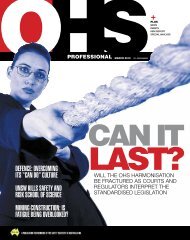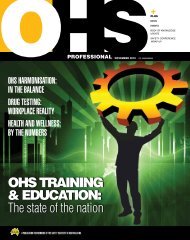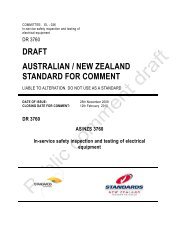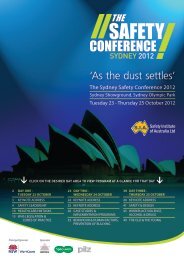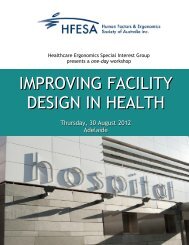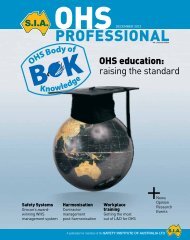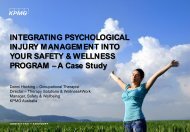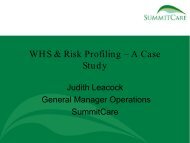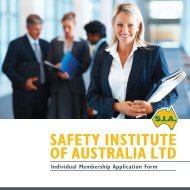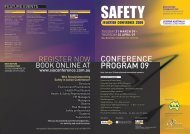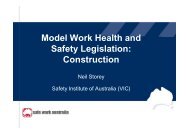Workplace bullying - Safety Institute of Australia
Workplace bullying - Safety Institute of Australia
Workplace bullying - Safety Institute of Australia
Create successful ePaper yourself
Turn your PDF publications into a flip-book with our unique Google optimized e-Paper software.
heightsafety<br />
position the injured worker to a point where they could be quickly<br />
extracted from the ro<strong>of</strong>.<br />
Work positioning<br />
Rope access is a form <strong>of</strong> work positioning but encapsulates this<br />
skill-set into an entire systemised approach.<br />
Many industries use work positioning in extremely safe ways<br />
(such as power industry with use <strong>of</strong> pole straps), and the appeal<br />
<strong>of</strong> work positioning over the final area in the harness-based hierarchy<br />
(fall arrest) is that it seeks to prevent a fall from happening.<br />
So no fall equals no consequences, bleeding, injury or the need<br />
for a rescue – surely a better outcome.<br />
Rope access operators are <strong>of</strong>ten seconded in this area to manage<br />
a team <strong>of</strong> persons working in work positioning. A typical example<br />
<strong>of</strong> this was the cladding <strong>of</strong> the Melbourne Southern Cross<br />
Station ro<strong>of</strong>, where carpenters, sheeters and plumbers received<br />
basic rope access training to allow them to undertake safe work<br />
positioning, while a senior rope access operator looked after the<br />
team by setting up anchors and diversions, providing assistance<br />
with difficult areas and if necessary, providing rescue skills. This<br />
was used on one occasion when a worker lacerated his knee with<br />
a power tool and the rope access system was used to move and<br />
Fall arrest<br />
Unfortunately, too many workers are asked to work in harnesses,<br />
and are effectively at risk <strong>of</strong> a fall due to a range <strong>of</strong> factors relating<br />
to the site, workers, equipment and site management. If a fall is<br />
allowed to take place, there is the strong possibility <strong>of</strong> personal<br />
injury and even equipment failure (over sharp edges for example)<br />
and there is also the need for a prompt rescue.<br />
The word “restraint” gets used a lot in relation to harnessbased<br />
works. The recently updated series <strong>of</strong> AS/NZS 1891 Standards<br />
have made some careful distinctions in this area. While it<br />
is not law to comply with the standard, the contract <strong>of</strong> the job,<br />
company policy etcetera may require compliance. The updated<br />
standard requires that all harness-based systems should be<br />
designed for fall arrest loads, even if being used for restraint (that<br />
is, preventing a person from reaching a fall potential point). It also<br />
promotes the technique <strong>of</strong> restraint as desirable because it is<br />
likely to prevent a fall from taking place. However should a fall occur,<br />
at least the system is unlikely to fail due to the higher loads.<br />
Working at heights, particularly when relying on harnessbased<br />
methods, is rarely as simple as it looks. If work must be<br />
carried out using harness-based methods, the use <strong>of</strong> rope access<br />
– properly carried out – or work positioning are always the best<br />
approaches.<br />
Peter Ferguson is past<br />
president and committee<br />
member <strong>of</strong> ARAA<br />
and convenor <strong>of</strong> ISO<br />
rope access Standard<br />
Committee. peter@<br />
firstaccess.com.au.<br />
LADDER<br />
REPLACEMENT<br />
WORK PLATFORMS<br />
PLATFORM FEATURES<br />
• Compact footprint<br />
• Rated max load 240kg<br />
• Quick ascent and descent<br />
• Indoor/outdoor use on flat level surfaces<br />
• Standard doorway access<br />
• Battery powered convenience<br />
• Dual control points<br />
• Maintenance safety bars<br />
WORKING HEIGHTS<br />
• UB6/UBM6 3.8m<br />
• UB8/UBM8 4.5m<br />
• UB10/UBM10 5.0m<br />
UNCOMPROMISED<br />
SAFETY<br />
EASY OPERATION<br />
OUTSTANDING<br />
RELIABILITY<br />
LIFETIME ECONOMY<br />
Quick Access products are made under<br />
ISO9001 quality management system<br />
and fully compliant with European CE<br />
standards, EN280 and EN60204-1.<br />
These products are also fully compliant<br />
with <strong>Australia</strong>n standards AS1418.10.<br />
ACCESS HOLDINGS INTERNATIONAL Pty Ltd<br />
Phone 02 9749 5686 | Email access@ahiholdings.com<br />
www.ahiholdings.com<br />
September 2011 | OHS PROFESSIONAL 27




